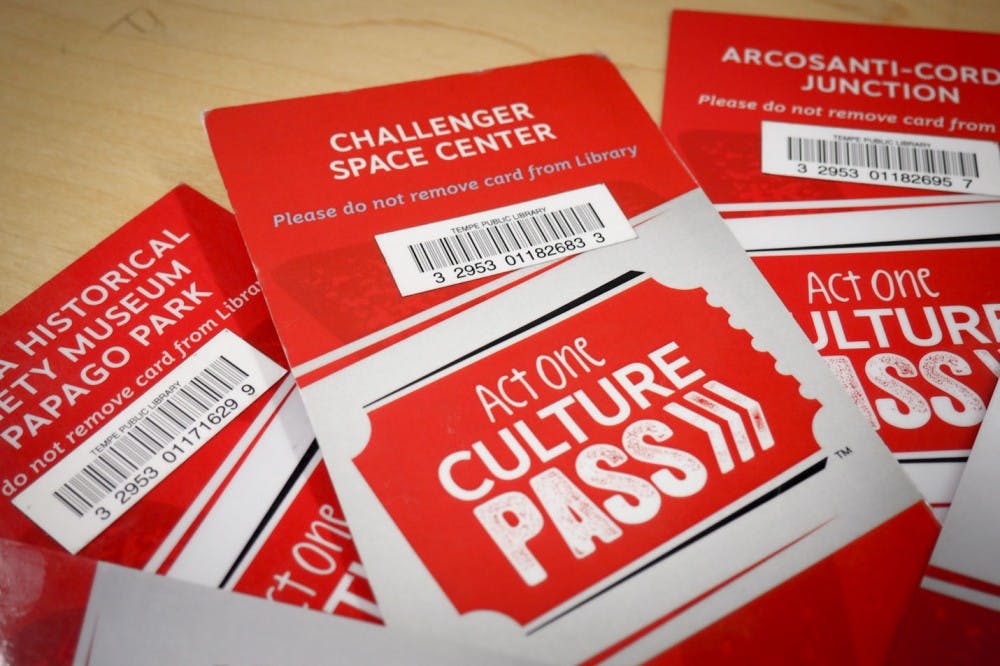An age old question that plagues many college students when boredom hits is: “What do you want to do?” With so many options surrounding ASU, the answer should be easy, but many have one devastating downfall — a dollar sign.
Luckily, there is an answer to this recurring question at Hayden library, Polytechnic campus library, Fletcher library and the Downtown Phoenix campus library: culture passes. These free passes to adventure act as tickets to different facilities around Arizona, and many are just a light rail trip away. These facilities include the Arizona Science Center, Phoenix Art Museum and the Heard Museum among others.
How do they work?
Henry Stevens, the evening operations supervisor at Hayden Library, said he has used the passes and would recommend checking out the Heard Museum.
“The fact that I was able to get in for free was enticing,” he said.
Stevens also said those interested in the passes can look up them up through the online library catalogue to find out if they are available or not, and when they will become available in the future.
“You have a week to use them and the receipt is your ticket for admission, which admits two people,” he said.
Culture passes are easy to use, and they can be checked out from the library like a book. Most of the passes are set up behind the desk. If anyone has difficultly locating them, the librarians are happy to assist, they will scan the pass and give the student a receipt for entry.
Limitations
While these passes are a great opportunity, they are not without limitation. Only one pass can be checked out per week, and that pass must be used within the week or it is no longer valid. Also, its access does not apply to all exhibits within the facility. Special exhibits will still cost money to enter.
For example, using a culture pass at the Arizona Science Center will allow access to the main and permanent exhibits throughout the center such as the “Get Charged Up” or “Forces of Nature” exhibits. However, the current and temporary exhibit “POP-nology” would cost extra to view. The movies played in its theater are unavailable by use of a culture pass.
Most Popular Passes
The three most popular passes tend to be the Arizona Science Center, the Phoenix Art Museum and the Desert Botanical Gardens.
Health and wellness sophomore Dotti Givens said she was interested in getting a culture pass to the Arizona Science Center. She said culture passes help spark ideas for different places to go near ASU.
“I think it helps (students) get in touch with any activities they can do around campus and around the city,” she said.
The Arizona Science Center offers an interactive way to experience science. The “Forces of Nature” exhibit includes a platform where visitors get to experience different types of weather. Lights heat up the room, and then the next moment the ground is shaking like an earthquake. Rain sprinkles on top of everyone as wind whips their hair around like a hurricane.
Another exciting exhibit at the Arizona Science Center is “Get Charged Up” where guests can have a tug-of-war contest with the “Giant Lever” where the placement of the rope gives one side an unfair advantage, illustrating principles of physics. This exhibit also offers a bed of nails to show guests that an equal distribution of weight across all the points reduces the pressure each applies, keeping them from impaling the daring participants.
The Phoenix Art Museum offers access to multiple exhibits throughout the museum. One is the “Throne Rooms” where guests can look at miniature versions of different rooms, replicated down to the most minute details. The exhibits throughout the art museum give visitors an idea of how art has evolved over time, from beautifully detailed religious paintings to the current exhibit “Super Indian,” which showcases the works of contemporary Native American artist Fritz Scholder.
The art museum's culture passes allow guests to walk into the FireFly installation by Yayoi Kusama — a pitch black room lined with mirrors and filled with pin-points of colored light that seem to reflect into infinity.
Lesser used passes
Other available passes include, but are not limited to, Arcosanti-Cordes Junction, Challenger Space Center, Deer Valley Rock Art Center, Halle-Hear Children’s Museum and Heard Museum.
The Heard Museum stands out from its home on Central Avenue with it’s large grass lawn. The museum is an unusual large white building with a central courtyard, and as guests walk to ticket admissions, they pass by both the Coffee Cantina and Courtyard Café and the Heard Museum Shop and Books and More, making the building feel a bit more like a village than a museum.
However, upon entering the museum that feeling immediately shifts. Tours are included with the culture pass for free and are a great way to learn more about Native arts and culture, which the Heard Museum focuses on.
Sophomore psychology major Karen Brave said she thinks culture passes allow students to do things they might not regularly try.
“Get (students) out of their comfort zone, going everywhere else, and they might actually be able to understand and learn about other cultures,” she said.
The Heard Museum is just one example of a culture pass that deserves more use, so the next time the “What do you want to do?” question comes up, consider exploring one of the many options provided by the culture pass program at ASU's libraries.
Reach the reporter at ndusanek@asu.edu or follow @ NikkiDusanek on Twitter
Like The State Press on Facebook and follow @statepress on Twitter




